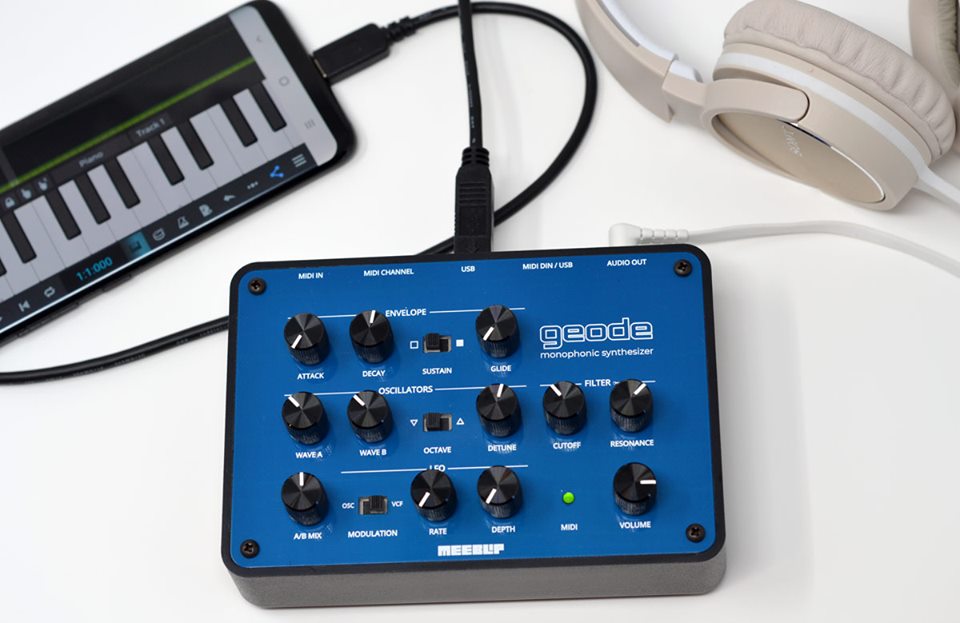It’s liberating – just take your phone or tablet, plug in a USB cable, and you can make music on this hardware synth anywhere. Here’s how to do that, with our MeeBlip geode, plus some tips on the best apps for both iOS and Android.
Inspiration is a funny thing, and somehow in the process of hunting around for interfaces and power sockets, you can wind up staring at a tangle of cables and no idea of what it was you were trying to do. So, I’m already finding it surprisingly empowering to be able to use the new USB port on the MeeBlip geode for both power and MIDI (sequencing notes and control). Every smartphone I’ve tested, plus the iPad, will gladly power the geode from the same connection.

Why not just use an app? Well, with the geode plugged in, you get some nice feeling knobs and switches, plus that grimy, dirty MeeBlip sound – and its screaming analog filter. To look at it the other way, all you need for different interfaces for playing this module, from step sequencers to touch keyboards, is your handy mobile gadget.
That also led me on a search for the best apps that support MIDI out. Not all do, Apple’s own GarageBand for iOS being notably incapable of the feat (unlike its Mac sibling). I also spoke with Ashley Elsdon, our resident mobile geek, for additional tips. So these apps will be working with lots of my other MIDI gear, too. And while I thought the Huawei Android handheld that I just got to replace my iPhone would leave me disappointed as far as music apps, I was glad to find some excellent Android-platform stuff, too. (For once, we don’t have to leave y’all out.)
First, here are a couple of jams on iOS, audio straight from the out jack of the MeeBlip. And these two I think count as my two favorite live performance tools for iOS (so far):
Mobile MeeBlip in action!
StepPolyArp may have been one of the first music apps I got for the iPad, actually. It’s an intuitive, deep combination of a piano roll editor for graphically drawing patterns, an arpeggiator, and a step sequencer. It syncs to Ableton Link, though I’ve also used plain MIDI clock. And yes, you can get grimy sounds out of geode, in case you didn’t know that.
https://dev.laurentcolson.com/steppolyarp.html
Arpeggionome Pro has a unique grid (influenced by the likes of the Tenori-On), and runs on both iPhone and iPad – it’s great handheld. Because of its particular approach to harmony and rhythm, it can lead you to some patterns you’d never play on a normal arpeggiator, let alone on a keyboard (unless you’re seriously some kind of pinball wizard). And yes, it also boasts Ableton Link support, so you can wireless sync up to another app or computer running lots of different software (not just Ableton Live).
It’s also on iOS, though ARPIO is an Android port from the original developer, and just lacks MIDI support – please, please!
More app ideas
On Android, there’s a powerful MIDI sequencer/arpeggiator toolkit that lets you build your own patterns:
https://play.google.com/store/apps/details?id=midi.midi.midi.looper.free&hl=en_US
Wildly enough, you can even use the Virtual ANS, a reimagining of a vintage Soviet synth, with MIDI output. The developer tells me he’s working on bringing that same MIDI output to his excellent tracker/production tool SunVox, where it makes more sense:
https://play.google.com/store/apps/details?id=nightradio.virtualans3
Various production tools on Android also do MIDI output, though perhaps the easiest to use would be Touch DAW, which simply acts as a general-purpose MIDI controller for everything – including a keyboard.
iOS is as usual richer with options. Ashley / Palm Sounds recommends considering MIDI plug-ins, too.
apeMatrix as host + AUv3 MIDI plug-ins
Rozeta sequencer suite from our friend Ruismaker (or if you want to get really fancy, try scripting your own MIDI with Mozaic)
And there’s Fugue Machine, also from Alexandernaut who built Arpeggionome above, which could be wild. I might have to try that with multiple MeeBlips, uh, fuguing. Stay tuned.
Or think of Modstep, a powerful sequencer with scene triggering
What do you need for the connection?
On many new Android devices, you can actually plug a cable directly between your phone (USB-C) and the MeeBlip (USB-B). Otherwise, you’ll need a USB OTG adapter. These run about ten bucks (ah, this obviously isn’t from Apple).
On iOS with only Lightning connections, you need an adapter. The best of these is Apple’s Lightning to USB3 Camera Connection Kit. It’s pricey, but it gives you both a USB-A and a separate Lightning breakout, so you can power your iPad or iPhone and connect USB at the same time, rather than drain the battery. It’s reliable enough to use live onstage, and it’s what you’ll see me using in these images.
Of course, on a computer with a standard USB connection, you don’t need any special adapters.
Regardless, you’re sure to be able to quickly connect your MeeBlip in the studio or at home, and you can even mess around with ideas on the go or busk at the park or picnic.
MeeBlip geode is shipping now. Grab one if you don’t have it already for US$149.95, direct from us.